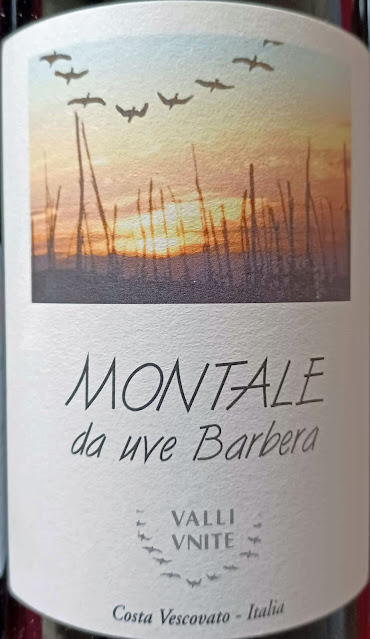Two Highly Recommended Wines for you, a Barbera from Italy and a Vermentino from Languedoc-Roussillon.
*************
Valle Unite Montale Barbera Colli Tortonesi (DO) 2013, 14%
RRP & stockists: €23.95, Le Caveau Kilkenny, 64 Wine, Greenman Wines, Bradleys Cork
While Nebbiolo may be the star (think Barolo!), Barbera is the popular everyday red wine grape in Piedmont; those wines from Asti and Alba are probably the best-known of the varietal. With high acidity and alcohol, low tannin and sweetness, Barbera is approachable and affordable. This particular Barbera has the advantage of being organic.
Colour is a mid ruby, somewhat lighter around the edge. This may be of the 2013 vintage but the nose is fresh and complex, its ripe cherries hinting at youth rather than age. And that complexity is striking on the palate as is the typical acidity. Smooth and well balanced right to the end, some grip still there though as it lingers long. Dry in the end and very satisfactory indeed.
Pasta, veal, pork, and game are the regularly suggested pairings. Wine Folly say roasted and vegetable-driven dishes while Wine-Searcher goes for Seared rabbit livers, Thai duck noodle soup, and Roasted, herb-crusted lamb rack. I think the lamb would be my first port of call!
They also produce an excellent white. Recent review here.
Highly Recommended.
*************
Click here for growing list of top wines for 2023
*************
Domaine Bassac Le Vermentino du Grand Mur Nos Parcelles Côtes de Thongue 2021, 14% ABV
A wine new to Mary Pawle list, expect to pay €20 to 21. Contact: Mary Pawle Wines
Vermentino is mostly a grape of the Mediterranean coast, grown mostly in Italy (all over the country but most notably in Sardinia and Tuscany) and France (widely in the Languedoc-Roussillon and also in Provence). Expect citrus (lemon, lime), apples and a lively acidity. Best drunk when young.
Our wine here, part of which has been barrel fermented, comes from Languedoc-Roussillon, from the Côtes de Thongue. The vineyard is situated at Puisalicon, a small medieval village in the heart of the Languedoc not too far from Beziers, a town that rugby fans will be familiar with. Domaine Bassac is a family estate of several generations standing and much of its wine is exported. Pioneers in organic farming, current operators François Delhon (family member) and Jean-Philippe Léca have been doing it organically since 1987.
The colour is quite a light straw, shimmering bright in the glass. Light fruity and herbal notes in the aromatics. Good firm fruit flavours follow, citrus mostly with hints of tropical, and also the expected (but certainly not over the top) acidity that ensures balance.
,
This dry and fruity wine should pair well with pasta, vegetarian dishes, poultry, lean fish, and also as an aperitif.
Highly Recommended
*************
Click here for Good Value Wine List 2023
*************
















